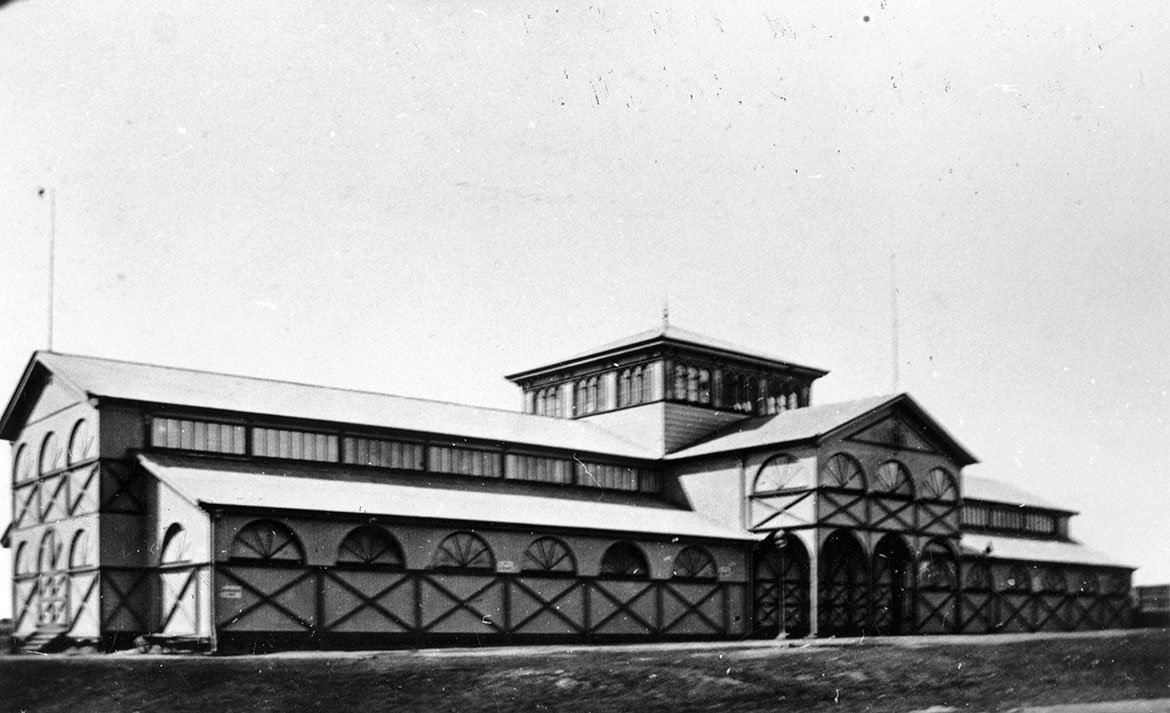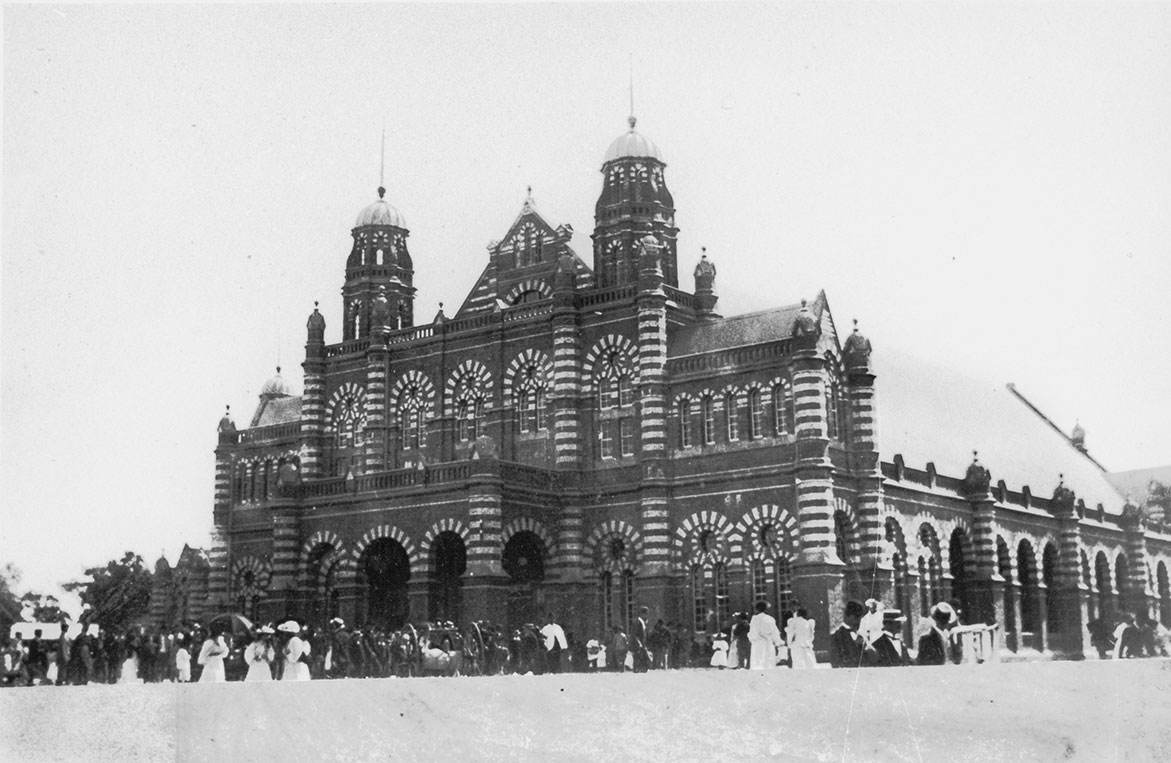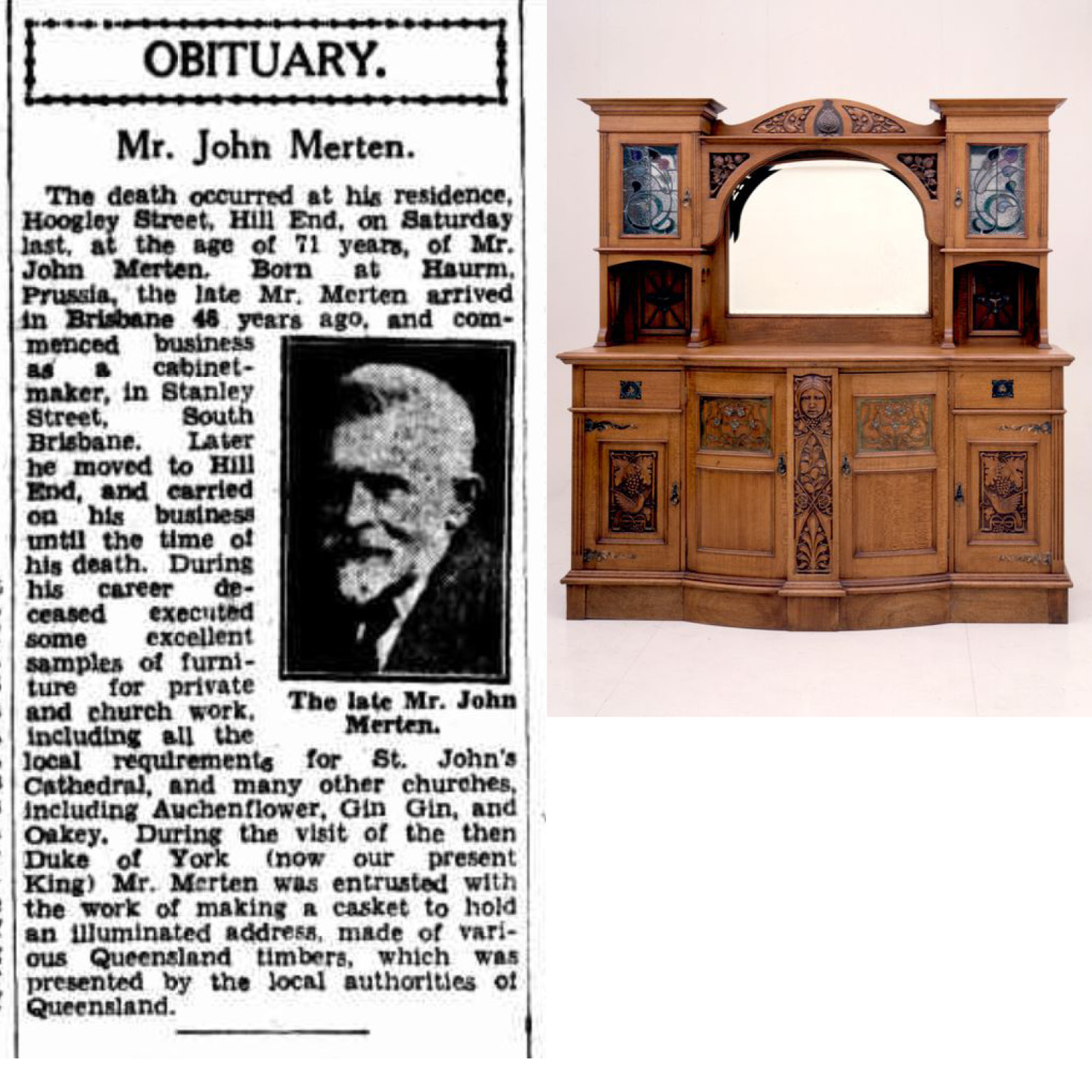[ad_1]
There is little furniture from the Arts and Crafts period in Queensland that can match the fluid carving of the art nouveau foliate motifs in this hallstand from the 1920s, the scale and workmanship bears the mark of two of Queensland’s finest craftsmen — John Merten and Lewis Jarvis (LJ) Harvey.
John Merten (1861-1932) was born in Germany and records show that he was one of the most talented apprentices of his year. Merten arrived in Brisbane with his family in 1887 and commenced business as a cabinetmaker in Stanley Street, South Brisbane, and by 1888 was awarded a First Order of Merit for a walnut box and a black bean and pine writing desk at his first exhibition.
The most consistent exhibition venue for cabinetmakers in Brisbane from the late nineteenth century was the annual exhibition of the Queensland National Agricultural and Industrial Association and when Merten exhibited in the ‘artisan’ section his furniture was always highly praised. Between 1888 and 1931 Merten exhibited workboxes, bookcases, sideboards, writing desks, and several suites of dining and bedroom furniture.
DELVE DEEPER: Discover more fascinating Queensland Stories
National Agricultural and Industrial Association of Queensland
Bowen Park (now known as the Brisbane Showgrounds) was the site for the first Queensland Intercolonial Exhibition in 1876, the exhibition was organised to promote the state’s agricultural, pastoral, and industrial resources, including showcasing local arts and crafts, and manufactured goods. The park was bordered by Bowen Bridge Road, O’Connell Terrace, Brookes Street and Gregory Terrace and the month of August was chosen as ideal due to its generally fine weather, it avoided any clashes with local shows, stock feed was available, and it was before the spring shearing season.
Queensland resources and produce on display



With the success in attracting 17,000 visitors on opening day when Brisbane’s population at the time was just 22,000, the exhibition became a permanent fixture in Brisbane’s social calendar. Brisbane’s first Exhibition Building at Bowen Hills (illustrated) used by the Queensland National Agricultural and Industrial Association was destroyed by fire on 13 June 1888 and was replaced by the current Exhibition Building and Concert Hall (Old Museum Building) (illustrated). The current building was built in 1891, however the Queensland Government took control of the building and grounds when the National Association was forced into liquidation by the economic depression in 1897.
Fine Arts on display in the original Exhibition Building, 1886-87


Brisbane Showground Exhibition Building, destroyed 1888

Exhibition Building (Old Museum Building), built 1891

Main arena, 1896

The expanded main arena & ring events by 1906

John Merten’s connection to St John’s Cathedral
During the visit to Brisbane in May 1901 by the Duke and Duchess of York, the then Prince George, and Mary (the future King George V and Queen Mary) where they laid the foundation stone of St John’s Cathedral (illustrated), Merten was entrusted with making a carved casket (illustrated) from native woods including Black bean, with a drop front, into which is slotted a watercolour illuminated manuscript address which was presented by the Government of Queensland (now in the Royal Collection Trust, UK).
Merten was also commissioned to design liturgical furniture for the Victorian Gothic style Cathedral. The first stage of construction began in 1906 and took four years to complete, constructed from ‘Brisbane Tuff’ and Helidon sandstone from the Lockyer Valley Region of southeast Queensland, east of Toowoomba. Helidon sandstone was used extensively in public buildings at the time, including the Brisbane Treasury Building (construction started 1886), Brisbane City Hall (construction started 1920), and the University of Queensland (construction started 1938).
Laying of the foundation stone, 1901

Construction of St John’s Cathedral,1906


John Merten ‘Address casket’, 1901

Prince George at Government House, 1901

John Merten & LJ Harvey ‘Hallstand’ 1920
Of particular interest here is Merten’s collaboration with Queensland’s principal Arts and Crafts practitioner, Lewis Jarvis (LJ) Harvey (1871-1949) as, at that time, carving and cabinetmaking were distinct trades. Harvey, an accomplished carver, lived on Gray Road, Hill End (now Brisbane’s West End), less than 100 metres from Merten, who resided in Hoogley Street. Harvey collaborated with Merten on two major sideboards: a neo-Renaissance style for Harvey’s wife in 1909; the other in art nouveau c.1925 (Collection: Museum of Applied Arts & Sciences, Sydney) (illustrated). It is known that Harvey also carved motifs on other examples of Merten’s cabinetwork.

‘Queenslander’ furniture
The furniture that decorated the typical ‘Queenslander’ home in Brisbane during the first half of the twentieth century was essentially a simplified Arts and Crafts style. The preferred timber was silky oak and, although Black bean (Moreton Bay chestnut) is native to the Brisbane area, it was used from the 1890s in small quantities.
From the nineteenth century the native forests of south east Queensland provided a resource for building and cabinet timber. The silky oak’s primary significance locally was as a cabinet timber — it achieved recognition at the Queensland National Agricultural and Industrial Association exhibition in 1901 when manufacturer, John Hicks and cabinet-maker, John Merten were awarded First Orders of Merit for bedroom suites. John Hicks established his furniture business in the 1860s in Albert Street, Brisbane and led to a series of relocations and expansions over the decades that followed. For the next forty years silky-oak became the dominant timber used to furnish ‘Queenslander’ homes for the bedroom, lounge and dining rooms.
Black bean was also considered a valuable source of timber, its dark-brown to almost black timber somewhat resembles walnut. Black bean derives its name from its large bean-like seeds from flushes of yellow and red flowers during summer, however these seeds are the poisonous part of the plant, and the timber’s sawdust is also toxic.
RELATED: Lewis Jarvis (LJ) Harvey
John Merten, who had the reputation of being one of the finest cabinet makers in Australia, continued to make furniture for some 50 years, while LJ Harvey is appreciated locally for his woodcarving — he was a prominent figure within Queensland’s Arts and Crafts Movement in the first half of the 20th century — he also inspired the largest school of art pottery in Australia during the 1920s and 30s.
Edited curatorial extracts, research and supplementary material compiled by Elliott Murray, Senior Digital Marketing Officer, from Glenn R Cooke, former Curator (Queensland Heritage), QAGOMA.

#QAGOMA
[ad_2]
Source link
